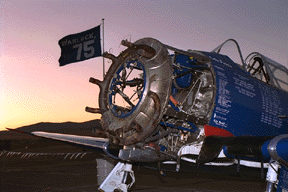 |
 |
"The 1995 Never Say Die trophy goes without question to Al Goss of Woodland, Calif., his #75 SNJ Warlock and his indefatigable crew."
- Pacific Flyer, Oct. 1995

It had been a scheduled "practice start" and Warlock, like many of the competitors, had not yet officially "qualified" for the races. They were tuning up to turn in a peak performance for the "on the clock" qualifying lap which would determine post positions for the upcoming heat races on Thursday and Friday. The practice starts give the pilots a chance to turn the pylons in the company of their colleagues and feel out the course with some traffic to contend with. Warlock had started out well, pilot/owner Al Goss turning the dive lap with the grace that only 15 years of experience at these races can bring. Then trouble struck. The red indicator light on the instrument panel flickered on then glowed brightly as Warlock shuddered on the backstretch of the racecourse. Al instinctively shut off the engine and pulled up high over Stead airfield and called to the tower "Mayday! Mayday! Race 75 off the course". It was the "chip indicator" light, proclaiming that metal chips had struck the oil screen that had caught Al's attention.
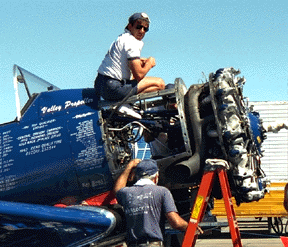
As he surveyed the airfield and selected a runway to bring the injured racer in "deadstick", Al hoped against hope that the problem was fixable and the quick shutdown had spared the engine from breaking down completely. Safely on the ground, the bird didn't LOOK like it had any problems - no oil dripping off the cowling like in Phoenix after the T6 gold race in March '94. That problem grounded Warlock at Williams AFB until the engine could be repaired in L.A. and brought back to Arizona.
Word came back fairly early - the bearing for the master rod had failed and sprayed metal throughout the engine case. The 9-cylinder radial engine was history.
Before you can say "Legal Eagle", Kay Scott of the aircraft insurance company of the same name was on her cell phone, working her connections, searching for a "spare" P&W R1340. Unlike the big-money unlimited class racing teams, the T-6 teams generally don't carry spare motors to the races. Early in the afternoon it was confirmed - an engine awaiting overhaul had been located at a Richvale cropdusting outfit, and the owner, Craig Compton was amenable to the loan. The engine had over 900 hours of crop-dusting work since its last overhaul and was leaking oil, but was flyable. Al would drive his pickup truck back across the Sierras to the central valley to pick up the motor and return to Reno with it that evening. The crew would pull the prop and engine off the crippled Warlock in the meanwhile and be ready to work all night to assemble and mount the borrowed motor. There was little time to spare - the deadline to qualify for the races was 3:00 pm the following day! Warlock had a shot at the Bronze race anyway!
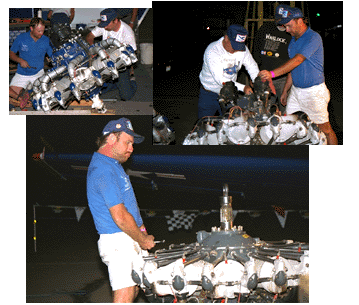
And so began an unbelievable effort by the team to resurrect the T-6 racer. Stunned and depressed, they had started slowly, dismantling and dismounting the broken engine. But when Al arrived on schedule with a big round motor in the back of his truck, the excitement began to rise dramatically. Even a contingent of the legendary airrace band "the WingNuts" arrived at the Warlock pit to take advantage of the generators set up for the pit lights and entertain the mechanics with Stratocaster surf music and Hendrix tunes like "Little Wing".
Like a hive of bees, the mechanics swarmed over the two engines lying side by side on the tarmac with the engine-less airplane looming behind them, removing parts from the one and attaching to the other as the night wore on. Finally it was time to fork-lift the cropduster motor up onto the proud NAVY-marked racer. As the tail-dragger points up at about a 20-degree angle anyway, and Warlock's gas-pressured struts were uneven from the hot emergency landing causing a slight roll to the left, mounting the engine was a tricky affair, but accomplished with surprising proficiency, considering it was 3 a.m. and the crew was exhausted physically and emotionally! The prop slipped on the new engine like they were old friends. There was still much to be done, but it would wait for daylight.
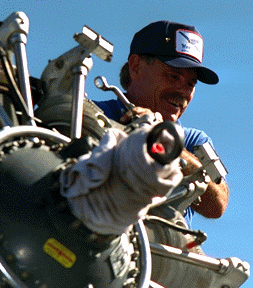
By the next morning, hope was running high that Warlock would qualify to race in the designated 3pm "qualifying window" assigned to the T-6 class. Some of the crew began the rituals of "wax on - wax off" polishing which makes the aircraft extra "slippery" in the air, enhancing its performance every so slightly in this closely-matched "stock" racing class. The rest were still busy readying the newly mounted engine. At last Warlock was towed back on to the ramp for a run up. As breaths were held, the engine coughed twice, belched some smoke and kicked into life - idling at first, then roaring as Al turned up the rpms for a real test. The team's spirits soared until the oil started pouring out onto the tarmack from the bottom of the engine compartment - the oil cooler was leaking bad. It could be replaced but it would be very close to the deadline before it could be tested again, let alone flown. The work began, but the tension in the pit was so thick, nobody really talked. It looked like we wouldn't make the time cutoff. There was some discussion that the other T-6 competitors would "concede" Warlock a qualifying time if she could get airborne at all today. This was a testament to the unblemished string of gold and silver race finishes Warlock had accumulated over the last fifteen years - a veritable "Cal Ripken" of air racing competition. They didn't expect Warlock to give them any trouble this year, but felt she deserved at least to appear in the bronze race.
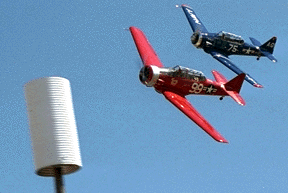
The qualifying window came and went and Warlock remained in the pit. Then came word that there was a protest filed challenging a qualifying time for another racer, and the qualifying window was re-opened. Warlock fired up again, this time no leaks, and went out and turned an official lap of 219.18 mph at 4:55pm. The tower closes the race course at 5pm daily. That qualifying speed - only 5 mph slower than the original engine unofficially clocked earlier - plus strong performances in the heat races placed Warlock once again in the gold race of the national championships - the six fastest T-6s in the competition!
In Sunday's championship gold race, Al passed John Luther in "Texas Red" to take 4th place and finish Reno '95 in one of the most exciting T-6 races in memory.


 Back to Air Racing home page
Back to Air Racing home page
